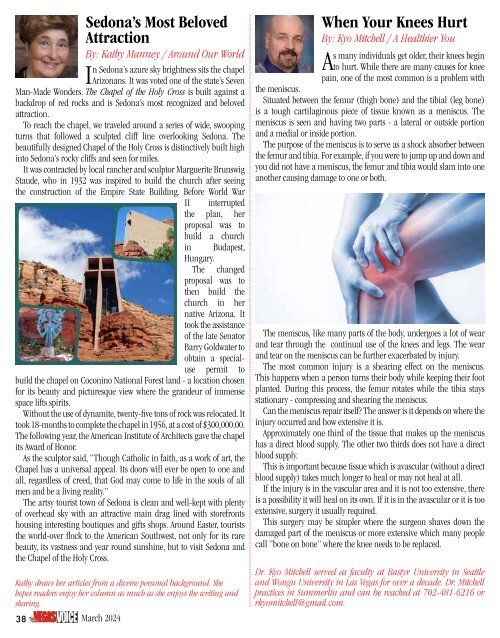You also want an ePaper? Increase the reach of your titles
YUMPU automatically turns print PDFs into web optimized ePapers that Google loves.
By: Kathy Manney / Around Our World<br />
In Sedona’s azure sky brightness sits the chapel<br />
Arizonans. It was voted one of the state’s Seven<br />
Man-Made Wonders. The Chapel of the Holy Cross is built against a<br />
backdrop of red rocks and is Sedona’s most recognized and beloved<br />
attraction.<br />
To reach the chapel, we traveled around a series of wide, swooping<br />
turns that followed a sculpted cliff line overlooking Sedona. The<br />
beautifully designed Chapel of the Holy Cross is distinctively built high<br />
into Sedona’s rocky cliffs and seen for miles.<br />
It was contracted by local rancher and sculptor Marguerite Brunswig<br />
Staude, who in 1932 was inspired to build the church after seeing<br />
the construction of the Empire State Building. Before World War<br />
38 <strong>March</strong> <strong>2024</strong><br />
Sedona’s Most Beloved<br />
Attraction<br />
II interrupted<br />
the plan, her<br />
proposal was to<br />
build a church<br />
in Budapest,<br />
Hungary.<br />
The changed<br />
proposal was to<br />
then build the<br />
church in her<br />
native Arizona. It<br />
took the assistance<br />
of the late Senator<br />
Barry Goldwater to<br />
obtain a specialuse<br />
permit to<br />
build the chapel on Coconino National Forest land - a location chosen<br />
for its beauty and picturesque view where the grandeur of immense<br />
space lifts spirits.<br />
Without the use of dynamite, twenty-five tons of rock was relocated. It<br />
took 18-months to complete the chapel in 1956, at a cost of $300,000.00.<br />
The following year, the American Institute of Architects gave the chapel<br />
its Award of Honor.<br />
As the sculptor said, “Though Catholic in faith, as a work of art, the<br />
Chapel has a universal appeal. Its doors will ever be open to one and<br />
all, regardless of creed, that God may come to life in the souls of all<br />
men and be a living reality.”<br />
The artsy tourist town of Sedona is clean and well-kept with plenty<br />
of overhead sky with an attractive main drag lined with storefronts<br />
housing interesting boutiques and gifts shops. Around Easter, tourists<br />
the world-over flock to the American Southwest, not only for its rare<br />
beauty, its vastness and year round sunshine, but to visit Sedona and<br />
the Chapel of the Holy Cross.<br />
Kathy draws her articles from a diverse personal background. She<br />
hopes readers enjoy her column as much as she enjoys the writing and<br />
sharing.<br />
When Your Knees Hurt<br />
By: Kyo Mitchell / A Healthier You<br />
As many individuals get older, their knees begin<br />
to hurt. While there are many causes for knee<br />
pain, one of the most common is a problem with<br />
the meniscus.<br />
Situated between the femur (thigh bone) and the tibial (leg bone)<br />
is a tough cartilaginous piece of tissue known as a meniscus. The<br />
meniscus is seen and having two parts - a lateral or outside portion<br />
and a medial or inside portion.<br />
The purpose of the meniscus is to serve as a shock absorber between<br />
the femur and tibia. For example, if you were to jump up and down and<br />
you did not have a meniscus, the femur and tibia would slam into one<br />
another causing damage to one or both.<br />
The meniscus, like many parts of the body, undergoes a lot of wear<br />
and tear through the continual use of the knees and legs. The wear<br />
and tear on the meniscus can be further exacerbated by injury.<br />
The most common injury is a shearing effect on the meniscus.<br />
This happens when a person turns their body while keeping their foot<br />
planted. During this process, the femur rotates while the tibia stays<br />
stationary - compressing and shearing the meniscus.<br />
Can the meniscus repair itself? The answer is it depends on where the<br />
injury occurred and how extensive it is.<br />
Approximately one third of the tissue that makes up the meniscus<br />
has a direct blood supply. The other two thirds does not have a direct<br />
blood supply.<br />
This is important because tissue which is avascular (without a direct<br />
blood supply) takes much longer to heal or may not heal at all.<br />
If the injury is in the vascular area and it is not too extensive, there<br />
is a possibility it will heal on its own. If it is in the avascular or it is too<br />
extensive, surgery it usually required.<br />
This surgery may be simpler where the surgeon shaves down the<br />
damaged part of the meniscus or more extensive which many people<br />
call “bone on bone” where the knee needs to be replaced.<br />
Dr. Kyo Mitchell served as faculty at Bastyr University in Seattle<br />
and Wongu University in Las Vegas for over a decade. Dr. Mitchell<br />
practices in Summerlin and can be reached at 702-481-6216 or<br />
rkyomitchell@gmail.com.
















